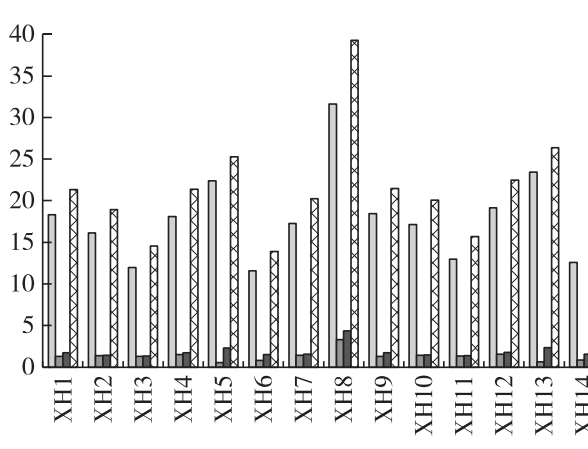 PDF(2219 KB)
PDF(2219 KB)


不同无性系四川桤木嫁接苗生物量及其分配特征
白文玉, 冯茂松, 铁烈华, 汪亚琳, 高嘉翔, 赖娟, 戴晓康
南京林业大学学报(自然科学版) ›› 2021, Vol. 45 ›› Issue (2) : 87-95.
 PDF(2219 KB)
PDF(2219 KB)
 PDF(2219 KB)
PDF(2219 KB)
不同无性系四川桤木嫁接苗生物量及其分配特征
Biomass and its allocation characteristics of one-year-old grafted seedlings of different clones of Alnus ledgeriana
 ,
,
【目的】研究不同无性系四川桤木1年生嫁接幼苗的生物量及其分配特征,了解不同无性系嫁接幼苗对环境的适应策略和能力,为筛选适宜地区发展的优良无性系提供依据。【方法】采用随机区组设计方法,将苗圃地划分为3个区组,每个区组包含若干个小区。2015年11月将采自四川省宣汉县、恩阳区和金堂县的34株四川桤木优树穗条嫁接于长势基本一致的砧木上,每小区内约嫁接100株(重复3次)。2016年8月中旬测定小区内所有嫁接幼苗的株高和基径,根据测定结果在每个小区内选出3株平均株作为待测植株,测定待测植株不同部位的生物量,采用单因素方差分析和系统聚类分析方法比较不同无性系嫁接幼苗生物量及其分布特征的差异。【结果】四川桤木嫁接幼苗地上部分鲜质量表现为叶>主干>侧枝,叶片和主干相对含水量在50%以上。叶片和主干在地上部分生物量中占比较大,侧枝生物量占比最小;地下部分各根径生物量大小表现为粗根>细根>中根。生物聚类分析表明,34个四川桤木无性系嫁接幼苗可分为3类,其中第2类无性系幼苗总生物量最大,第1类次之,第3类最小。3类无性系幼苗之间生物量分配比较,第2类无性系植株分配给侧枝和细根的生物量最大;第1类无性系植株主干生物量占比较高,而叶片和细根生物量占比最小;地下以第3类无性系植株叶片生物量占比最大,侧枝和主干生物量占比最小,粗根生物量占比最大。【结论】不同无性系四川桤木1年生嫁接幼苗的生物量及生物量分配特征具有一定差异,其中第2类无性系幼苗总生物量最大且各器官生物量分配较均匀,可能对光照条件和土壤水热条件的适应能力最强;第1类无性系总生物量次之,可能对光照条件适应能力较强,但是对土壤水热条件的适应能力不高;第3类无性系总生物量最低,可能对环境的适应能力最低。
【Objective】To understand the adaptation strategies and capabilities of grafted seedlings of different Alnus ledgeriana clones to the environment and select excellent clones for regional development, we investigated the biomass and allocation characteristics of one-year-old grafted seedlings of different clones of A. ledgeriana.【Method】The random block design method was used to divide the study site into three blocks, and each block contained 34 plots. Thirty-four dominant A. ledgeriana were collected from Xuanhan, Enyang and Jintang of Sichuan Province. The spikelets of dominant trees were grafted onto rootstocks with the same growth in November 2015. Approximately 100 rootstocks were grafted in each plot and repeated three times in different blocks. The plant heights and base diameters of all grafted seedlings in each plot were measured in mid-August 2016. Three average plants were selected as the study plants in each plot based on the heights and base diameters. We determined the biomass of each part of the study plants and then analyzed the differences in biomass and its allocation characteristics among different clones using ANOVA and systematic cluster analysis.【Result】The aboveground part of the fresh weight of the A. ledgeriana clones was ranked as leaf > trunk > lateral branch, and the relative water content of each part was more than 50%. The leaf and trunk were the heaviest parts of the aboveground biomass, and the lateral branch was the lightest part. The underground part of the biomass was ranked as rough root > fine root > medium root. Cluster analysis showed that the 34 A. ledgeriana clonal seedlings were divided into three categories. The second category of clonal seedlings had the largest total biomass, then the first category, and the third category was the smallest. The biomass allocation characteristics of the three categories of clonal seedlings were also different. The ratios of the biomass of lateral branches and fine roots in the second category of clonal seedlings were larger than those in the first and third categories. The ratios of the biomass of lateral branches and trunks in the first category clonal seedlings were relatively high, while those of leaves and fine roots in the first category clonal seedlings were lower than those in the second and third categories. The ratio of the biomass of leaves in the third category clonal seedlings was greater than that in the first and second categories, the ratios of the biomass of lateral branches and trunks in the third category clonal seedlings were lower than those in the first and second categories, and the ratio of the biomass of rough roots in the third category clonal seedlings was the largest.【Conclusion】The biomass and allocation characteristics of different one-year-old A. ledgeriana clones were distinct. Among them, the total biomass of the second category clonal seedlings was the largest and their allocation characteristics were evenly distributed, supporting that the second category clonal seedlings may have the strongest adaptability to light and soil hydrothermal conditions. The total biomass of the first category clonal seedlings suggest that they may have relatively strong adaptability to light conditions but relatively poor adaptability to soil hydrothermal conditions. The total biomass of the second category of clonal seedlings was the lowest, indicating that they may have the weakest adaptability to the environment.

四川桤木 / 无性系 / 生物量 / 枝 / 叶 / 根 / 生物量分配 / 聚类分析
Alnus ledgeriana / clone / biomass / branch / leaf / root / biomass allocation / cluster analysis
| [1] |
饶龙兵, 李阳, 郭洪英, 等. 5种桤木属植物苗期生长性状比较研究[J]. 中南林业科技大学学报, 2016,36(1):18-25.
|
| [2] |
刘柿良, 马明东, 潘远智, 等. 不同光强对两种桤木幼苗光合特性和抗氧化系统的影响[J]. 植物生态学报, 2012,36(10):1062-1074.
|
| [3] |
李苏梅, 龙春林, 刀志灵. 传统农业生态系统中桤木改良土壤效应研究综述[J]. 植物生态学报, 2006,30(5):878-886.
|
| [4] |
郭洪英, 杨汉波, 陈炙, 等. 四川桤木7×7完全双列杂交种实、种苗性状的遗传效应分析[J]. 植物研究, 2018,38(3):357-366.
|
| [5] |
彭方仁. 无性繁殖的进展及其在无性系林业中应用前景[J]. 世界林业研究, 1990,3(4):74-81.
|
| [6] |
|
| [7] |
谢然, 陶冶, 常顺利. 四种一年生荒漠植物构件形态与生物量间的异速生长关系[J]. 生态学杂志, 2015,34(3):648-655.
|
| [8] |
|
| [9] |
|
| [10] |
|
| [11] |
王俊峰, 冯玉龙. 光强对两种入侵植物生物量分配、叶片形态和相对生长速率的影响[J]. 植物生态学报, 2004,28(6):781-786.
|
| [12] |
贾庆彬, 王晓伟, 邹建军, 等. 大青杨无性系材性分析与优良无性系选择[J]. 森林工程, 2020,36(2):12-19.
|
| [13] |
颜绍馗, 汪思龙, 于小军, 等. 桤木混交对杉木人工林大型土壤动物群落的影响[J]. 应用与环境生物学报, 2004,10(4):462-466.
|
| [14] |
王军辉, 顾万春, 李斌, 等. 桤木优良种源/家系的选择研究:生长的适应性和遗传稳定性分析[J]. 林业科学, 2000,36(3):59-66.
|
| [15] |
马莹玲, 朱思佳, 曾思如, 等. 木麻黄和桤木离体根瘤和立地土壤的固氮酶与N2O还原酶活性的研究[J]. 热带亚热带植物学报, 2019,27(2):121-128.
|
| [16] |
白文玉, 铁烈华, 冯茂松, 等. 不同种源桤木嫁接幼苗的生长及光合特性[J]. 四川农业大学学报, 2018,36(1):46-51.
|
| [17] |
纪凯婷, 芦建国, 郭聪聪. 夏蜡梅1年生实生苗的生长节律[J]. 西北农林科技大学学报(自然科学版), 2015,43(9):165-170.
|
| [18] |
董道瑞, 李霞, 万红梅, 等. 塔里木河下游胡杨(Populus euphratica)地上生物量估测[J]. 中国沙漠, 2013,33(3):724-730.
|
| [19] |
刘畅, 孙鹏森, 刘世荣. 植物反射光谱对水分生理变化响应的研究进展[J]. 植物生态学报, 2016,40(1):80-91.
|
| [20] |
郭芳芸, 哈蓉, 马亚平, 等. CO2浓度升高对宁夏枸杞苗木光合特性及生物量分配影响[J]. 西北植物学报, 2019,39(2):302-309.
|
| [21] |
白蕾, 单立山, 李毅, 等. 降雨格局变化对红砂幼苗根系生长和生物量分配的影响[J]. 西北植物学报, 2017,37(1):163-170.
|
| [22] |
卢雪佳, 刘方炎, 高成杰, 等. 金沙江干热河谷车桑子生殖枝生物量分配的性别差异[J]. 西北植物学报, 2018,38(9):1733-1739.
|
| [23] |
李鑫, 李昆, 段安安, 等. 不同地理种源云南松幼苗生物量分配及其异速生长[J]. 北京林业大学学报, 2019,41(4):41-50.
|
| [24] |
姜琦, 陈光水, 陈廷廷, 等. 增温下土壤资源异质分布对杉木幼苗生长的影响[J]. 应用生态学报, 2019,30(7):2156-2164.
|
| [25] |
陈俊华, 周大松, 牛牧, 等. 川中丘陵区4种乡土阔叶树细根性状对比研究[J]. 南京林业大学学报(自然科学版), 2020,44(1):31-38.
|
| [26] |
姚甲宝, 楚秀丽, 周志春, 等. 不同养分环境下邻株竞争对木荷和杉木生长、细根形态及分布的影响[J]. 应用生态学报, 2017,28(5):1441-1447.
|
| [27] |
曾艳, 伊晓云, 李延升, 等. 氮肥对夏秋季茶树吸收根生物量和养分储量的影响[J]. 生态学报, 2016,36(2):411-419.
|
| [28] |
舒文将, 柴胜丰, 黎兆海, 等. 不同光强对棱角山矾幼苗生长及光合特性的影响[J]. 植物研究, 2017,37(4):556-562.
|
| [29] |
孙洪刚, 刘军, 董汝湘, 等. 水分胁迫对毛红椿幼苗生长和生物量分配的影响[J]. 林业科学研究, 2014,27(3):381-387.
|
| [30] |
牛素贞, 宋勤飞, 樊卫国, 等. 干旱胁迫对喀斯特地区野生茶树幼苗生理特性及根系生长的影响[J]. 生态学报, 2017,37(21):7333-7341.
|
| [31] |
李国斌, 李光跃, 孙窗舒, 等. 干旱胁迫对蒙古黄芪生物量及其根际微生物种群数量的影响[J]. 西北植物学报, 2015,35(9):1868-1874.
|
| [32] |
|
| [33] |
胥生荣, 张恩和, 马瑞丽, 等. 不同覆盖措施对枸杞根系生长和土壤环境的影响[J]. 中国生态农业学报, 2018,26(12):1802-1810.
|
| [34] |
姚甲宝, 楚秀丽, 周志春, 等. 3个与杉木混植木荷种源幼苗对光照响应的差异[J]. 林业科学研究, 2018,31(6):144-153.
|
/
| 〈 |
|
〉 |